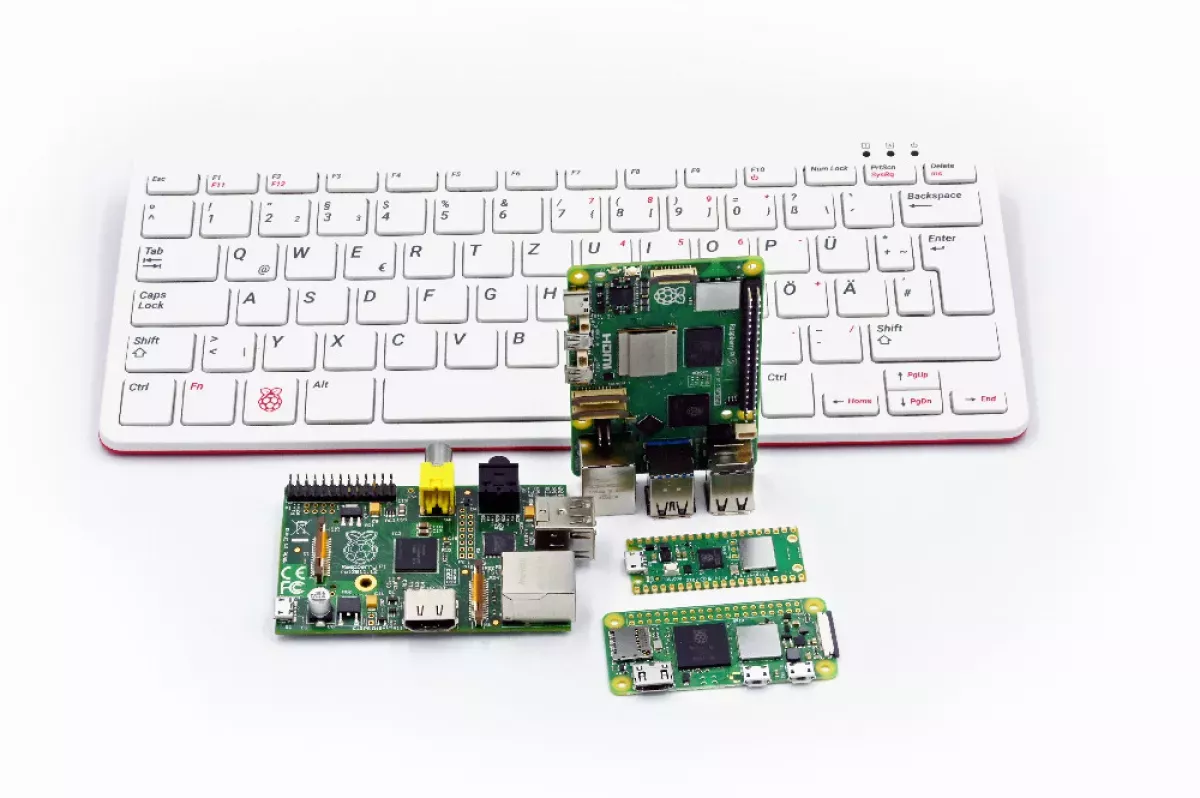Raspberry Pi is a series of single-board computers (SBCs) originating from the UK. Initially developed by the Raspberry Pi Foundation with Broadcom, Raspberry Pi Ltd. took over production in 2012 as a subsidiary. In June 2024, Raspberry Pi established Raspberry Pi Holdings and became a publicly traded company on the London Stock Exchange.
1981: Inspiration from BBC Micro
In 1981, Acorn's BBC Micro inspired the Raspberry Pi computer. Later Raspberry Pi models A, B, and B+ referenced the original models of the BBC Micro.
1997: CPU Performance Comparison
The CPU performance of the first generation Raspberry Pi, operating at 700 MHz, is similar to that of a 300 MHz Pentium II from 1997.
2001: Graphical Capabilities Comparison
The graphical capabilities of the Raspberry Pi are roughly equivalent to the performance of the Xbox of 2001.
2006: Early Raspberry Pi Concepts
In 2006, early Raspberry Pi concepts were based on the Atmel ATmega644 microcontroller. Schematics and PCB layouts were made publicly available.
2008: Eben Upton among the Raspberry Pi Foundation Founders
In 2008, Eben Upton was part of the original Raspberry Pi Foundation group.
2008: Raspberry Pi Foundation Created
In 2008, the Raspberry Pi Foundation was created as a private company limited by guarantee.
2009: Raspberry Pi Foundation Registered as a Charity
In 2009, the Raspberry Pi Foundation was registered as a charity, aiming to address the decline in computer science skills among young people.
May 2011: Raspberry Pi as a Potential BBC Micro 2.0
In May 2011, technology writer Glyn Moody described the Raspberry Pi project as a "potential BBC Micro 2.0", aiming to supplement PC compatible machines rather than replace them.
January 2012: High Interest in Raspberry Pi from UK Schools
As of January 2012, schools in the United Kingdom, particularly private schools, showed significant interest in the Raspberry Pi board.
February 2012: Orders open for Model B
On 29 February 2012, the Raspberry Pi Foundation started accepting orders for the higher-priced Model B, initially priced at US$35.
March 2012: Echoes of BBC Micro Successor Sentiment
In March 2012, Stephen Pritchard echoed the sentiment of the Raspberry Pi as a BBC Micro successor in ITPRO.
October 2012: Raspberry Pi Wins Innovation of the Year Award
In October 2012, the Raspberry Pi won T3's Innovation of the Year award. Also in October 2012, the British Computer Society expressed great interest in the Raspberry Pi after the announcement of enhanced specifications.
October 2012: Model B with 512 MB RAM Released
On 15 October 2012, the later Model B with 512 MB RAM was released. About a week later, a new version of start.elf was released that could dynamically assign RAM to the GPU, obsoleting the older method of splitting memory.
2012: Raspberry Pi (Trading) Ltd Established
Following the release of the second board type, Raspberry Pi (Trading) Ltd was established in 2012 to develop Raspberry Pi computers, with Eben Upton appointed as CEO. The Foundation focused on promoting computer science education.
2012: Raspberry Pi Products Developed by Raspberry Pi Ltd
In 2012, Raspberry Pi Ltd, a wholly-owned subsidiary of the Raspberry Pi Foundation, assumed responsibility for the development of all Raspberry Pi products.
February 2013: Orders open for Model A
On 4 February 2013, the Raspberry Pi Foundation started accepting orders for the lower-cost Model A.
May 2014: OTTO Digital Camera Kickstarter Campaign
In May 2014, the OTTO digital camera, which incorporates a Raspberry Pi Compute Module, was successfully crowd-funded through a Kickstarter campaign.

June 2014: TECHBASE Releases ModBerry
In June 2014, TECHBASE, a Polish industrial automation manufacturer, released ModBerry, an industrial computer based on the Raspberry Pi Compute Module, for industrial IoT solutions.

August 2014: Slice Digital Media Player Kickstarter Campaign
In August 2014, Slice, a digital media player utilizing a Compute Module and running on Kodi-based software, was successfully crowd-funded through a Kickstarter campaign.
November 2014: Launch of Model A+
On 10 November 2014, the Raspberry Pi Foundation launched the even lower cost (US$20) Model A+.
December 2014: Astro Pi Project Launch
In December 2014, the Astro Pi project, an augmented Raspberry Pi with a sensor hat and visible light/infrared camera, was launched at an event held by the UK Space Agency.
2014: Free Learning Resources Launched and Teacher Training Course Started
In 2014, the Raspberry Pi Foundation launched free learning resources for its website and initiated a teacher training course called Picademy to support computing education using the Raspberry Pi.
February 2015: 5 Million Raspberry Pis Sold
According to Raspberry Pi, more than 5 million Raspberry Pis were sold by February 2015, making it the best-selling British computer.
February 2015: Raspberry Pi 2 U16 Chip Vulnerability
In February 2015, it was discovered that the U16 switched-mode power supply chip of the Raspberry Pi 2 Model B version 1.1 was vulnerable to flashes of light, particularly from xenon camera flashes and laser pointers, due to its WL-CSP packaging exposing the bare silicon die.
November 2015: Launch of Raspberry Pi Zero
On 26 November 2015, the Raspberry Pi Zero, the cheapest Raspberry Pi yet, was launched at US$5 or £4.
2015: Raspberry Pi Becomes Best-Selling British Computer
In 2015, the Raspberry Pi surpassed the ZX Spectrum in unit sales, becoming the best-selling British computer.
2015: The MagPi Handed Over to Raspberry Pi (Trading) Ltd
In 2015, the community-developed fanzine The MagPi was handed over to Raspberry Pi (Trading) Ltd by its volunteers to be continued in-house.
May 2016: USB Gadget Support Added to Raspbian
In May 2016, support for using the RPi Zero, RPi1A, RPi3A+ and RPi4 as a USB device or "USB gadget" was added to the mainline Raspbian distribution.
November 2016: 11 Million Raspberry Pis Sold
By November 2016, 11 million Raspberry Pi units had been sold.
2016: BCM2836 SoC Discontinued
As of late 2016, the Broadcom BCM2836 SoC used in the earlier V1.1 model of the Raspberry Pi 2 was no longer in production.
March 2017: 12.5 Million Raspberry Pis Sold
By March 2017, 12.5 million Raspberry Pi units had been sold, making it the third best-selling 'general purpose computer'.
June 2017: Raspberry Pi Wins Royal Academy of Engineering MacRobert Award
In June 2017, the Raspberry Pi was awarded the Royal Academy of Engineering MacRobert Award for its impact on computing engagement, education, and innovative control solutions.
March 2018: Sales Climb to 19 Million
By March 2018, Raspberry Pi sales climbed to 19 million units.
March 2018: SUSE Announces Commercial Support for SUSE Linux Enterprise
In March 2018, SUSE announced commercial support for SUSE Linux Enterprise on the Raspberry Pi 3 Model B for industrial monitoring implementations.
2018: NASA's JPL Open Source Rover Project
In 2018, NASA launched the JPL Open Source Rover Project, using a Raspberry Pi as the control module for a scaled-down version of the Curiosity rover, aimed at engaging students and hobbyists in engineering disciplines.
June 2019: Raspberry Pi 4 Launch
In June 2019, the Raspberry Pi 4 was launched with options for 1, 2, 4, or 8 GB of RAM. The 1 GB model was available at launch.
December 2019: 30 Million Devices Sold
By December 2019, a total of 30 million Raspberry Pi devices had been sold.
February 2020: Vulkan Driver Development Announced
In February 2020, Raspberry Pi first announced its work on a Vulkan driver.
March 2020: Increased Demand Due to COVID-19 Pandemic
During the COVID-19 pandemic, demand for Raspberry Pi increased due to remote work and its use in ventilators in countries such as Colombia. In March 2020, Raspberry Pi sales reached 640,000 units, marking the second-largest sales month in the company's history.
March 2020: Discontinuation of the 1 GB Raspberry Pi 4
In March 2020, the 1 GB model of the Raspberry Pi 4, originally launched in June 2019, was discontinued.
May 2020: Introduction of the 8 GB Raspberry Pi 4
In May 2020, the 8 GB model of the Raspberry Pi 4 was introduced.
November 2020: Vulkan 1.0 Conformance
On 24 November 2020, Raspberry Pi announced that their driver for the Raspberry Pi 4 is Vulkan 1.0 conformant.
January 2021: TECHBASE Announces Raspberry Pi Compute Module 4 Cluster
In January 2021, TECHBASE announced a Raspberry Pi Compute Module 4 cluster for AI accelerator, routing, and file server applications, featuring standard Raspberry Pi Compute Module 4s and Coral Edge tensor processing units.
October 2021: Reintroduction of the 1 GB Raspberry Pi 4
In October 2021, the 1 GB model of the Raspberry Pi 4 was reintroduced after being discontinued in March 2020.
October 2021: Vulkan 1.1 Conformance
On 26 October 2021, Raspberry Pi Trading announced further driver conformance for Vulkan 1.1.
December 2021: Astro Pi on NASA's Dragon 2
In December 2021, NASA launched the Dragon 2 spacecraft with a pair of Astro Pi computers on board.
2021: Raspberry Pi (Trading) Ltd Renamed
In 2021, Raspberry Pi (Trading) Ltd changed its name to Raspberry Pi Ltd.
April 2022: Shortage Prioritization
In April 2022, Raspberry Pi explained its approach to chip shortages, prioritizing business and industrial customers.
August 2022: Vulkan 1.2 Conformance
On 1 August 2022, Raspberry Pi Trading announced further driver conformance for Vulkan 1.2.
June 2024: Raspberry Pi Holdings Becomes Public
In June 2024, Raspberry Pi Holdings, the parent company of Raspberry Pi Ltd, became a public company and launched on the London Stock Exchange under the stock symbol RPI.
2024: Raspberry Pi Sales Success
As of 2024, Raspberry Pi devices, some costing as little as $35, have been widely adopted in diverse applications. By the time of the company's public listing in 2024, more than 60 million Raspberry Pi devices had been sold.
Trending
28 days ago Titanic Passenger's Gold Pocket Watch Anticipated to Break Auction Records, Selling for Millions.

27 days ago Ja'Marr Chase Suspended One Game: Spitting Incident Sparks Controversy, Appeal Pending
2 months ago Chris Witaske from 'The Bear' to be Grand Marshal in St. Charles Parade.

6 months ago Aaron Rodgers' Marriage Sparks Family Drama; Quarterback Finds Solace with Steelers

2 months ago Donovan Clingan impresses in Preseason; Predicted to achieve Double-Double average this season.

7 months ago Clowney Released by Panthers, Potential Trade to 49ers?
Popular

Candace Owens is an American conservative political commentator and author...

Ilhan Omar is an American politician currently serving as the...

XXXTentacion born Jahseh Dwayne Ricardo Onfroy was a controversial yet...

Tom Cotton is an American politician and Army veteran currently...

Oprah Winfrey an American talk show host television producer actress...
Matt and Ross Duffer known as the Duffer Brothers are...






